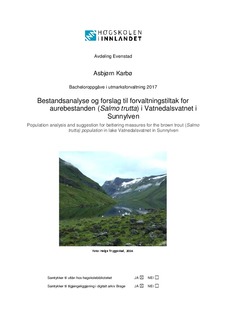Bestandsanalyse og forslag til forvaltningstiltak for aurebestanden (Salmo trutta) i Vatnedalsvatnet i Sunnylven
Bachelor thesis

Åpne
Permanent lenke
http://hdl.handle.net/11250/2446119Utgivelsesdato
2017Metadata
Vis full innførselSammendrag
Sommaren 2016 vart det satt i gong eit prøvefiske i Vatnedalsvatnet i Sunnylven, Stranda kommune, Møre og Romsdal. Formålet var og finne ut meir om tilhøva til aurepopulasjonen (Salmo trutta) og eventuelle tiltak for å betre desse for å få eit meir attraktivt fiskevatn.
Resultata viste ein tett og småvaksen aurebestand. Ein annan livsstrategi vart også dokumentert for auren. Enkelte individ er kannibalar og klarer å vekse seg større en majoriteten. Auren var også sterkt infisert av parasitten måsemakk (Diphyllobothrium dendriticum). 61 % av fangsten var infisert i større eller mindre grad.
Sjølv om bestanden er tett, vil eg ikkje anbefale å sette i gang tynningsfiske i Vatnedalen. Dette er grunna den store arbeidsmengda som krevjast og faren for å ta ut store fiskeetande individ.
Eg vil anbefale å innføre fangstbegrensning på fisk over 30 cm. Ved å spare desse kan ein få fleir store fiskeetande individ, noko som vil betre forholda for resten av auren.
For å hindre spreiing og minke omfanget av måsemakk, må fisk og fiskeavfall ikkje bli liggande tilgjengelig for måsar (Larinae).
Stor fiskeetande aure er ein ressurs i seg sjølv. Derfor har allereie Vatnedalsvatnet i dag eit attraktivt fisketilbod. In august 2016 a survey fishing was conducted in lake Vatnedalsvatnet in Sunnylven, Stranda municipality, Møre og Romsdal county. The purpose was to examine the brown trout population (Salmo trutta) and eventual measures to better the conditions for it, so that Vatnedalsvatnet becomes a better fishing location.
The results showed a dense trout population dominated by small and old individuals. A different life strategy was also discovered for the brown trout. Some individuals manage to become cannibalistic and get a much better growth than the rest of the population. The trout was also heavily infected with the tapeworm Diphyllobothrium dendriticum. 61 % of the catch was infected.
Although the population is dense, my recommendation is to not start with measures to thin the population. This is due to the large amount of work required, and the risk of removing big cannibalistic trout.
My recommendation is to prohibit killing of fish above 30 cm. By saving these, more big cannibalistic trout could appear, something that would help the rest of the population.
To prevent spreading and reduce the extent of the tapeworm, fish and wish waste must not be left available for Seagulls (Larinae).
Large cannibalistic fish is a resource by its own. Therefore, lake Vatnedalsvatnet has already today an attractive trout population for fishers.